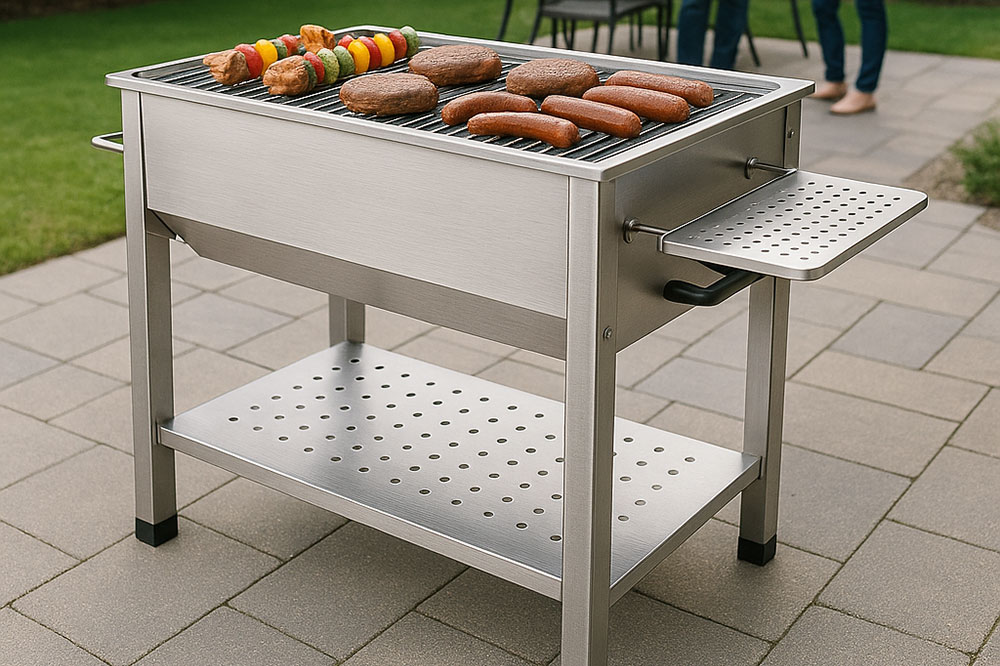Precision Hardware Customized Solutions Manufacturer
Custom Stainless Steel Barbecue Grills combine artistry, durability, and performance. Central to their construction are precise welding and bending techniques that ensure structural integrity, even heat distribution, and aesthetic appeal. In this article, we explore the key methods fabricators use to craft premium Custom Stainless Steel Barbecue Grills, including material selection, welding processes, bending approaches, and quality controls. We’ll also explain why Zhuhai Shengwo Machinery is the perfect partner for your custom grill projects and answer common questions in our FAQ section.
Contents
Custom Stainless Steel Barbecue Grills are engineered for durability and high performance. Typically made from 304 or 430 stainless steel, these grills resist corrosion, maintain shape under high heat, and deliver consistent cooking results. Key components include:
Frame and Cooking Chamber: Laser-cut panels welded into a sturdy box.
Cooking Grates: Cast iron or tubular stainless steel bars, bent precisely for perfect fit.
Ventilation and Controls: Integrated vents, dampers, and piezo igniters welded or brazed for reliability.
At the heart of every grill lies the welding and bending work that transforms flat sheets into sculpted, robust cooking stations.

Before welding or bending begins, choosing the right steel grade is critical:
Excellent corrosion resistance and formability.
Ideal for exterior panels and interior cooking surfaces.
430 Stainless Steel
More cost-effective, good for grill exteriors.
Slightly less corrosion-resistant but still durable under shelter.
Selecting the proper thickness (commonly 1.2–2.0 mm for panels, 3–5 mm for frames) balances strength, weight, and ease of fabrication.
Welding joins components into a single, leak-free assembly. Key precision welding methods include:
Precision CNC Metal Machining synergy: TIG welders often use CNC rotary fixtures to maintain exact alignment.
Benefits:
High control over heat input, minimizing distortion in Custom Stainless Steel Barbecue Grills.
Clean welds with minimal spatter, perfect for visible seams.
Applications:
Attaching burner tubes, brackets, and fine structural joints.
Speed and Efficiency: Faster deposition rates accelerate production of Custom Stainless Steel Barbecue Grills.
Shielding Gas: Argon–CO₂ mixes protect molten welds from oxidation.
Advantages:
Good for thicker sections (frames, support legs).
Easier to learn and automate for high-volume runs.
Sheet Joining: Spot welding joins overlapping panels for outer skins or internal partitions.
Strength: Creates localized fusion points without full seam welds.
Use Case:
Fastening drop-in grease trays or removable panels in Custom Stainless Steel Barbecue Grills.
Automation: CNC-guided laser heads deliver pinpoint welds along intricate contours.
Minimal Heat-Affected Zone: Preserves nearby metal properties, reducing warping.
Ideal For:
Continuous seams on large panel surfaces.
Complex geometry in premium Custom Stainless Steel Barbecue Grills.
Forming flat metal into three-dimensional shapes requires precise bending:
CNC Control: Computerized press brakes achieve exact angles and radii for grill hoods, doors, and drip pans.
Tooling: Custom-made dies produce consistent bends across batches of Custom Stainless Steel Barbecue Grills.
Best Practices:
Calculate springback for stainless steel, adjusting tooling angle accordingly.
Use air bending or bottoming methods depending on tolerance requirements.
Curved Panels: Roll bending machines shape panels for rounded grill bodies or smokeboxes.
Advantages:
Smooth, uniform curves without sharp creases.
Supports large-radius bending for premium grill designs.
Niche Applications: On presses or CNC mills, small incremental deformations form complex contours without dedicated dies—useful for one-off Custom Stainless Steel Barbecue Grills prototypes.

Integrating bending and welding techniques ensures structural performance:
Panel Fabrication: Laser-cut sheets first bent on press brakes to form sidewalls and bases.
Tack Welding: Initial tack welds hold panels at critical corners and edges.
Final Welding: TIG or MIG welders finish seams, ensuring full penetration and smooth finishes.
Post-Form Inspections: Check squareness, gap uniformity, and weld bead profiles.
This sequence minimizes distortion: bend first, then weld, then finish.
Ensuring every grill meets strict standards requires:
Dimensional Inspections: Calipers and gauges verify bend angles and panel dimensions.
Weld Visual Exams: Inspectors check for porosity, undercut, and bead consistency.
Pressure Testing: Sealed grill bodies undergo leak tests to validate seam integrity.
Surface Finishing: Grinding and polishing remove weld discoloration, ensuring corrosion resistance matches Custom Stainless Steel Barbecue Grills quality.
Zhuhai Shengwo Machinery excels in crafting high-end Custom Stainless Steel Barbecue Grills:
Precision Equipment: CNC laser cutters, multi-axis press brakes, and robotic TIG/MIG stations.
Material Expertise: Stock 304/430 stainless with SGS certification; in-house stress-relief and annealing.
Certified Quality: ISO 9001:2015 and ISO 14001 systems ensure consistent process control.
Flexible Customization: Modular designs—adjust size, finish, and ventilation per client specifications.
Rapid Prototyping & Production: CAD-to-sample in 48 hrs; batch runs in 7–15 days.
Turnkey Delivery: Includes labeling, packaging, and global shipping via ERP-managed logistics.
With over a decade of precision metal fabrication, Shengwo delivers durable, uniformly heated, and visually stunning Custom Stainless Steel Barbecue Grills for B2B clients worldwide.
Welding and bending are the foundation of every premium Custom Stainless Steel Barbecue Grill. From CNC press brake forming to TIG and robotic welding, each technique contributes to structural strength, heat consistency, and aesthetic quality. Zhuhai Shengwo Machinery combines advanced equipment, certified materials, and rigorous quality controls to deliver grills that exceed performance and durability expectations.
👉 Ready to craft your next signature grill? Contact Shengwo today for expert guidance, fast prototyping, and turnkey fabrication of Custom Stainless Steel Barbecue Grills tailored to your exact needs!
Q1: Which welding method is best for grill frames?
TIG welding is ideal for frame seams due to its precision and low distortion, while MIG welding suits thicker support brackets for speed.
Q2: How do you prevent distortion during bending?
By compensating for stainless steel springback in die design and sequencing bends before welds, distortion is minimized.
Q3: What thickness of stainless steel is recommended?
Commonly 1.5–2.0 mm for panels and 3–5 mm for structural members, balancing strength and flexibility in Custom Stainless Steel Barbecue Grills.
Q4: Can decorative bends be achieved without tooling?
Incremental sheet forming on CNC mills allows one-off decorative curves without dedicated dies.
Q5: How are welded seams finished for corrosion resistance?
Post-weld grinding and electropolishing restore the passive oxide layer, ensuring longevity.